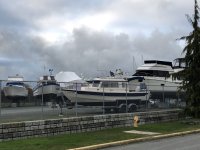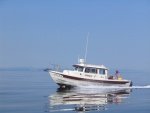Hi Murthog,
I'd say the CD 22 Cruiser might be just about the perfect first boat for your stated needs. We started cruising in a CD22. Here are the first few pages of my 2009 book, "Cruising in a Big Way":
INTRODUCTION
Have you ever watched a program on the whales, salmon, bears, eagles, and glaciers of Alaska, and dreamed of seeing the
wild and beautiful coast of British Columbia and Alaska for yourself?
How about up close and personal, in your very own boat?
In this book, we’ll describe how you could make that dream a reality, in a small (trailerable) boat.
If you’ve ever taken a cruise ship up to Alaska, along the way you may have noticed a few lucky folks poking along in their own boats, watching the whales, pulling in salmon or crab, or heading off to anchor in a secluded cove.
With a closer look at these private cruisers, you might observe that they’re not nearly as small as they appear from a distance. They might be affordable only with some really serious money. And then there’s the cost of fuel. So, you think, we sure couldn’t afford cruising like this.
But maybe you could…
Cindy and I have been lucky enough to spend more than 1,000 days cruising some 30,000 miles in our own small boats, mainly on the pristine waters of the Pacific Northwest. We aren’t wealthy, and we sure didn’t come into cruising as expert boaters – far from it. We were tent campers, who enjoyed fishing and liked being around the water.
We’ve wandered the Inside Passage as far as Glacier Bay, and floated in front of the great tidewater glaciers, while they calved huge chunks of ice. We’ve been surrounded by whales, porpoises, sea otters, seals and sea lions, dozens of eagles, and bears prowling the shoreline. We’ve feasted on succulent Dungeness crab, huge spot prawns, salmon, and halibut – all caught by us. In so many wonderful anchorages, we’ve been absolutely enchanted by the beauty all around us.
So how did tent campers become cruisers? While camping on Vancouver Island one summer, we decided to go out for a day with a salmon fishing guide. It was dynamite - beautiful, exciting, and great fishing too, all in a 16-foot boat.
Months later, we wandered into a boat show, thinking we could probably afford such a boat. We looked at quite a few, but none really knocked us out. Then we set eyes on a little cabin boat that really stood out from the crowd. It was a C-Dory 22 cruiser, not too much bigger than the fishing boats we were considering, but with a huge difference - it was designed for “camping on the water”. We spent several hours checking out every aspect of the C-Dory. After two more days at the boat show and lots of discussion, we were sold.
That little boat turned out to be one of the best decisions we ever made - a perfect choice for beginning cruisers. She was seaworthy as can be, built with quality, and very cleverly laid out to make the most of her 22 feet. Her cabin sheltered us from the weather, and had windows with all-round visibility. She had good cooking, eating, and sleeping facilities. With her 90hp outboard, she could cruise at 18-20 knots (21-23 mph), and travel 170 nautical miles (195 statute miles) on a tank of gas.
With this boat, we were able to spend peaceful weeks sightseeing on Lake Powell in southern Utah, then weeks and months exploring the Inside Passage of the Pacific Northwest.
The Inside Passage, a stretch of coast roughly 1000 miles long, runs northwest from Washington’s Puget Sound up to Glacier Bay in Southeast Alaska. It’s called the Inside Passage because its waters are protected by countless islands, in a mostly unpopulated area often 100 miles wide from east to west. Roads reach only a very small part of this wild, out-there place. It’s some of the finest cruising anywhere.
If you really want to, you could do this…
How much will it cost?
If you can afford a reliable small boat, cruising the gorgeous PNW coast really is possible. It doesn’t have to cost an arm and a leg.
Yes, the boat can set you back some serious cash – maybe $30K to $50K for a small or older cruiser, or $70K to well over $100K for one that’s new, larger, and more elaborately equipped. Boats certainly aren’t investments (except in your mental health and well-being), but if a new one strains the budget you can save a bundle by choosing the right used one. Upgrade a few things, take good care of it, and it should hold its value.
Once you have the boat, properly equipped and checked out, what will it cost to go cruising? Costs sure have gone up with fuel prices, but even with fuel at $4.00 a gallon, two people in a small boat can do a very nice cruise for $60-$90 per day. Some of the biggest cost factors:
How much time do you spend traveling at high speed? Especially in a heavier boat, going slower can double or triple your miles per gallon (and your range on a tank of fuel – handy for exploring remote areas). It can also reduce wear and tear, while increasing your enjoyment.
How much time do you spend at marinas, rather than at anchor?
How often do you eat at restaurants, rather than on board?
How much routine maintenance will you do yourself? Paying someone else to take care of your boat can really put a dent in your credit card.
What sort of a boat are we talking about?
You certainly could go cruising in a small sailboat, but sailboats aren’t our focus. In this book, we’re discussing small power cruisers, small enough to tow on a trailer. A larger boat that has to be kept in a slip will generally cost a lot more – partly for the boat, taxes, and insurance, partly for the slip, and partly for the wear and tear created by sitting in salt water all the time.
A towable Inside Passage cruiser is probably at least 21 feet long, and could be 26 or 27 without exceeding the typical 8½ foot maximum towing width. A 28 or 29 footer could be towable, but you might need a wide load permit.
For the PNW, a cabin is pretty much a requirement. We’ve seen a few folks cruising in open boats with enclosures, or boats with a cuddy cabin and an open helm, but we’d recommend a different choice. After all, a good part of the Inside Passage is known as the Rain Coast. Even if you stick to relatively sunny areas like the San Juan Islands, you will be spending some time in rain. A really functional, livable cabin, with good visibility all around, will make cruising a lot more comfortable and enjoyable.
In this book, we’ll describe boat designs, equipment, and techniques that work for us (or folks we know well). Of course, our suggestions aren’t the only way to do things, but we know they work for us. We’ll mention some brand names, so you can have examples of what we’re talking about. We do not imply that these are the only ones you should consider, or that they are the best – only that we or our friends have had success with them.
What skills and experience do you need?
Extended cruising of the Inside Passage is not without its challenges, but it certainly is do-able by mere humans like us. We learned step by step.
I had fished from skiffs with small outboard motors or oars, and done a little charter sailing in the Bahamas. Cindy and I had done some canoe paddling, but we knew nothing about owning and operating a power cruiser. Luckily for us, the C-Dory was an uncomplicated but very sound and seaworthy boat. It was a great learning environment - we concentrated on boating skills, not on stuff that didn’t work, or systems we just didn’t understand.
Before we took delivery, we attended the Boating Skills and Seamanship course put on by the Coast Guard Auxiliary. It cost only a few dollars, and couple of hours for each of six weeks – well worth it for us beginners.
For two years we were lake cruisers, staying out at first just a few days at a time, then working up to a couple of weeks. We built boating skills at Lake Powell, a low-risk and delightful place, with drop-dead gorgeous red rock canyon scenery. We learned what to take with us, how to load and provision the boat, towing, launching, docking, anchoring, boat handling in various conditions, and many aspects of living successfully aboard a small boat.
In our third year of cruising, friends in Seattle suggested that we tow up to Washington and meet them for a couple of weeks on the ocean. What an opportunity! A guided trip in the San Juan Islands and into British Columbia, expanding our envelope of skills and experience.
For our first ocean trip, we had to be prepared for many new things: tougher weather, bigger waves, huge tides, rapids, rain, fog, charts, navigation skills, and different kinds of fishing. We did our homework, and the cruise was a great success.
It was convenient that our boating buddies were leading the way, but with a cruising guide book and some common sense, we would probably have been OK in the San Juans. We planned ahead, and paid attention to what we were doing and how well it was working. As we ventured further north on subsequent trips, we encountered greater challenges with weather, waves, and distance. We took it one step at a time, learning as we went, rather than making great leaps beyond our abilities.
Over the next two summers, we spent six weeks cruising southern B.C. We had built up our skills to a pretty solid level, while both of us still held demanding jobs. Then came an opportunity to expand our envelope in a big way: both our employers were flexible enough to let us take extended leave.
We thought about it for a while, and decided to really go for it - a summer’s cruise in Southeast Alaska. It was incredibly wonderful, the experience of a lifetime. Since that first Alaska trip we’ve done many more long cruises, continually improving our skills, and loving (almost) every minute of it.
If you’d like to go confidently into the wilds of the Inside Passage, read on...



